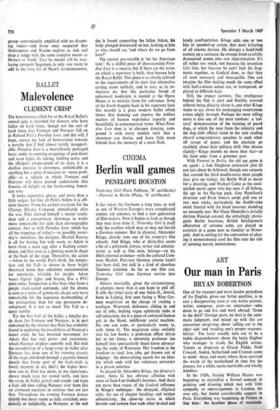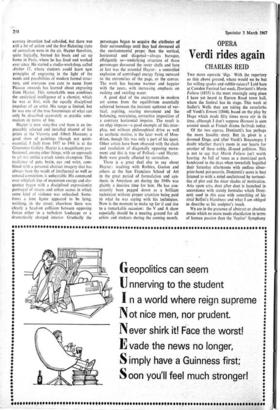Our man in Paris
ART BRYAN ROBERTSON
One of the meanest and most insular prejudices of the English, given our better qualities, is to cast a disapproving stare at any native painter, writer, composer, poet—or entertainer—who dares to go and live and work abroad. 'Gone to the devil' (foreign parts, no less) is the auto- matic judgment, and mixed up with this are censorious misgivings about 'selling out to the other side' and 'evading one's proper responsi- bilities.' The latter usually turn out to be a feeble disgruntlement about the lucky blighter who manages to evade the English winter. Talents as disparate at Gracie Fields, Noel Coward, Auden, Sutherland and Craxton come to mind: these, and many others, have survived the wrath of the motherland in time but the process, for a while, seems inevitable and wholly mindless.
In the 1920s, Stanley William Hayter was beginning to crystallise a formal concept in painting and drawing which met with little sympathy or encouragement in London, his own city, but found considerable support in Paris. Everything was happening in France at that time: the headiest phase of twentieth- century invention had subsided, but there was still a lot of action and the first flickering signs of surrealism were in the air. Hayter therefore, quite logically, burned his boats and set up home in Paris, where he has lived and worked ever since. He started a studio-workshop, called Atelier 17, where students could learn new principles of engraving in the light of the needs and possibilities of modern formal struc- ture, and everyone you care to name from Picasso onwards has learned about engraving from Hayter. This remarkable man combines the analytical intelligence of a chemist, which he was at first, with the equally disciplined impulses of an artist. His range is limited, but he was one of the true forerunners of what can only be described accurately as psychic auto- matism in terms of line.
Hayter is now sixty-five and there is an im- peccably selected and installed resumes of his prints at the Victoria and Albert Museum; a good show of paintings (though not quint- essential, I feel) from 1957 to 1966 is at the Grosvenor Gallery. Hayter is a magnificent pro- fessional, among other things, with an approach to art not unlike a crack tennis champion. This resilience of guts, brain, eye and wrist, com- bined with a personal abstract imagery that has always been the result of intellectual as well as sensual conviction, is unbeatable. His command over whiplash line of maximum energy and elo- quence began with a disciplined expressionist portrayal of streets and urban scenes in which some kind of violence was unleashed. Some- times a lone figure appeared to be lying, writhing, in the street; elsewhere there was clearly a head-on collision between opposing forces either in a turbulent landscape or a dramatically charged interior. Gradually the personages began to acquire the attributes of their surroundings until they had devoured all the environmental props; then the vertical, horizontal and diagonal—always baroque, effulgently so—underlying structure of those personages devoured the outer shells and here at last was the essential Hayter: a controlled explosion of centrifugal energy flying outward to the extremities of the page, or the canvas. The work has become warmer and happier with the years, with increasing emphasis on rushing and swirling water.
A good deal of the excitement in modern art comes from the equilibrium essentially achieved between the insistent upthrust of ver- tical, aspiring, soaring movement and the balancing, restraining, corrective imposition of a contrary horizontal impetus. The result is an edgy impasse—a good example of this inter- play, not without philosophical drive as well as aesthetic motive, is the later work of Mon- drian, though this was only a part of his quest. Other artists have been obsessed with the clash and resolution of diagonally opposing move- ment and this is true of Pollock—and Hayter. Both were greatly affected by surrealism.
There is a great deal else to say about Hayter: teaching with Rothko, Guston and others at the San Francisco School of Art in the great period of formulation and syn- thesis in American art during the 1940s was plainly a decisive time for him. He has con- sistently been pegged down as a brilliant technician without proper attention being paid to what he was saying with his techniques. Now is the moment to make up for it and rise to a remarkable occasion: the V and A show especially should be a meeting ground for all artists and students during the coming month.



































 Previous page
Previous page